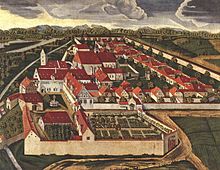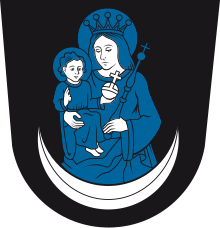Buxheim Monastery
Buxheim Charterhouse is a former monastery of the Carthusian and current branch of the Salesians of Don Bosco . It is in the Upper Swabian town of Buxheim near Memmingen in Bavaria and belongs to the diocese of Augsburg . The monastery was probably founded around 1100 as a collegiate monastery, given to the Carthusians as Maria Saal monastery in 1402 and used as such until 1812. From 1548 it was the only imperial chart of the Holy Roman Empire of the German Nation.
Today parts of the monastery are used by the German Carthusian Museum, the Salesians of Don Bosco and the adjoining grammar school as a boarding school and day care center. The monastery buildings are largely preserved. In the monastery church, one of the most expressive choir stalls of the Baroque can be seen with the Buxheim choir stalls .
history

The place was founded in the 7th century AD by the Alemanni . They named their home after the stream with the Celtic name Bux, which feeds the Iller . In the 10th century Luitgard, presumably the sister of Bishop Ulrich , gave the place to the Augsburg cathedral. The donation was linked to the condition of founding a collegiate foundation for priests in Buxheim, which began its service around 1100. In 1402 provost Heinrich von Ellerbach handed over the poor provost's office , which was on the verge of subsistence, to the Carthusians. The Charterhouse was given the name Maria Saal in 1406 by the Grande Chartreuse, the administration of the order. As a farming settlement with around 250 inhabitants, Buxheim fell under the rule of the Charterhouse. The monastery and its possessions became the most important employer for the population. During the turmoil of the Peasants' War (1524/25), the monastery residents had to experience the first plunder of their refuge, which was otherwise cut off from the outside world. They escaped from their Charterhouse. In 1543 only two monks and two lay brothers lived in the spacious monastery complex.
Protestantism
The monastery was initially under the protection of the imperial city of Memmingen . Together with the prior of Buxheim, the city held lower jurisdiction. In the course of the Schmalkaldic War (1546/47), the imperial city of Memmingen, which had become Protestant, occupied the monastery in 1546 and prohibited Catholic masses, choir prayer and the wearing of religious clothing. Another Protestant coercive measure was the obligation to attend Protestant sermons. As early as the following year the city was forced to lift its anti-religious orders. At the Reichstag in Augsburg in 1548, the prior of the monastery, Dietrich Loher , achieved the withdrawal of the Memmingers and the rank of prelate direct from the empire . King Ferdinand placed the monastery under the protection of the House of Habsburg and the Holy Roman Empire .
secularization
Buxheim was the only Imperial Charterhouse until secularization in 1802/3. In 1803 the Charterhouse came to the Count of Ostein , who let the convent exist, but no more novices were accepted. The last monk died in 1860. The monastery fell through inheritance in 1809 to Count Waldbott von Bassenheim , who used the complex as a castle from 1812. His son Count Hugo Waldbott , a notorious bankrupt, had the art-historically famous Buxheim choir stalls auctioned to England in 1883 . (In 1979 the Buxheim monastery church was bought back by the public sector.) In 1887, the count then sold the holdings and furniture of the library of the Buxheim monastery. In 1916 his heirs sold the former monastery church and the monastery buildings with the remaining land to the Kingdom of Bavaria. In 1925 they sold the archive, the vestments, the liturgical implements and the extensive collection of paintings to the Ottobeuren monastery .
In 1926 the abbey came into the possession of the Salesians . During the Second World War, part of the monastery was used by the staff of the NSDAP Reichsleiter Alfred Rosenberg . Also looted art has been deposited there. In 1947 the Salesians opened a boarding school, the Marianum , which was converted into a full high school in 1964.
description
Monastery complex
After the takeover by the Carthusians, the economic situation developed well, in the middle of the 15th century the old collegiate church was expanded, and by 1516 twenty-two monk houses were built along the cloister. Parts of the medieval monastery complex were redesigned in the 18th century by the Zimmermann brothers from Wessobrunn in the Baroque and Rococo styles . Dominikus and Johann Baptist Zimmermann designed the monastery church, the refectory and the cloister until 1713 , the parish church next to the monastery complex in 1727 and the St. Anna chapel in the cloister of the monastery between 1738 and 1741 . Several farm buildings and fish ponds belonged to the monastery.
Monastery church
The monastery church of St. Maria is a baroque hall church. The priest's choir was built in the 13th century, the brothers' choir was added in 1450. The largest church treasure is the baroque choir stalls that Ignaz Waibl created between 1687 and 1691. Between 1709 and 1711 the baroque style was pushed forward, with the Zimmermann brothers receiving and carrying out the orders. After the secularization, the priestly choir served the Counts of Bassenheim as a burial church. The Free State of Bavaria acquired the church building in 1916. The Salesians of Don Bosco received the right of use in 1955 and began extensive renovations in the church. With the return of the choir stalls, the dismantling began in the 1980s.
Rectors and priors of the Charterhouse
- 1403–1406 Ludovicus Verwig, founding rector
- 1406–1410 Ludovicus Verwig, prior
- 1410-1413 Joannes
- 1413-1423 Martinus
- 1423-1427 Fridericus
- 1427–1436 Michael Hartritt from Augsburg
- 1436–1439 Nicolaus from Giengen an der Brenz (first term of office)
- 1439–1442 Albert (Humel) Harhusen
- 1442–1465 Nicolaus from Giengen an der Brenz (second term of office)
- 1465–1467 Joannes Rock from Rottenburg
- 1467-1470 Bartholomaeus
- 1470–1471 Guntherus Molitor from Urach
- 1471–1477 Joannes Egen from Weingarten
- 1477–1481 Michael Schreppler
- 1481–1486 Udalricus Eckardt
- 1486–1489 Jodocus Wiedenmann from Memmingen (first term of office)
- 1489–1492 Petrus Luz
- 1492–1494 Jodocus Wiedenmann from Memmingen (second term of office)
- 1495 Joannes Mickel from Augsburg
- 1495–1497 Joannes Fabri
- 1497–1499 Henricus Gans from Winterthur
- 1499–1500 Balthasar Brügel from Nördlingen
- 1500–1501 Joannes Mosch
- 1501–1502 Gregorius Reisch from Balingen
- 1502–1507 Jacobus Louber (Lauber) from Lindau
- 1507–1510 Benedictus Eichel
- 1510–1516 Conradus Franckenberger from Fritzlar
- 1516–1535 Gregorius Mentelin
- 1535 Sebastianus Keger, rector
- 1535–1543 Thilemannus Mosenus
- 1543–1554 Dietrich Loher
- 1554–1555 Gerardus Bonn (Bohen) from Roermond
- 1555–1556 Georgius Eberhardi from Heusenstamm
- 1556–1557 Franciscus Hernich, Rector (first term of office)
- 1557–1558 Leonardus Fabri (Faber, Schmitt)
- 1558–1559 Franciscus Hernich, Rector (second term)
- 1559–1564 Joannes Rolandus from Aalst
- 1564–1572 Franciscus Hernich, Prior (third term)
- 1571–1572 Adamus Forman from Scotland, nominal prior
- 1572–1575 Hugo Wilhelmus Tryphaeus (Bletz) (first term of office)
- 1575–1585 Casparus Schliederer von Lachen
- 1585–1588 Lucas Pomisius
- 1588 Melchior Stich from Altdorf, rector
- 1588–1600 Hugo Wilhelmus Tryphaeus (Bletz) (second term of office)
- 1600–1606 Hugo Theveninus Edler von Bar from Saint-Dié
- 1606–1610 Benedictus Strambacher from Wallerstein
- 1610–1628 Bernardus Klump from Überlingen
- 1628–1666 Petrus Kalt from Constance
- 1666–1677 Petrus von Schneit from Cologne
- 1677–1678 Laurentius Fendrich from Molsheim
- 1678–1693 Joannes Bilstein from Cologne
- 1693–1711 Georgius Gottsauer
- 1711–1721 Petrus Leickard from Würzburg
- 1721–1743 Georgius Stock from Hainert
- 1743–1760 Hieronymus Krafft von Delmensingen
- 1760–1806 Hieronymus Pfeiffer from Binsfeld
- 1806–1811 Petrus Lipburger from Andelsbuch
- 1811–1812 Romualdus Geiger from Ottobeuren, director
literature
- The Buxheimer choir stalls . Contributions to the building and art history of the former Reich Charterhouse in Buxheim and the restoration of the choir stalls. In: Michael Petzet (Ed.): Workbooks of the Bavarian State Office for Monument Preservation, 66 . Munich 1994, ISBN 3-87490-569-1 .
- Ulrich Faust: Buxheim , in: Monasticon Cartusiense , ed. by Gerhard Schlegel, James Hogg, Volume 2, Salzburg 2004, 372-380.
See also
Web links
- Buxheim Monastery , basic data and history: Buxheim - Germany's largest Charterhouse in the database of monasteries in Bavaria in the House of Bavarian History
- Official website of the museum
Individual evidence
- ^ Buxheim Monastery , basic data and history: Buxheim - Germany's largest Charterhouse in the database of monasteries in Bavaria in the House of Bavarian History , as seen on August 18, 2009
Coordinates: 47 ° 59 ′ 58.2 ″ N , 10 ° 8 ′ 1.5 ″ E





